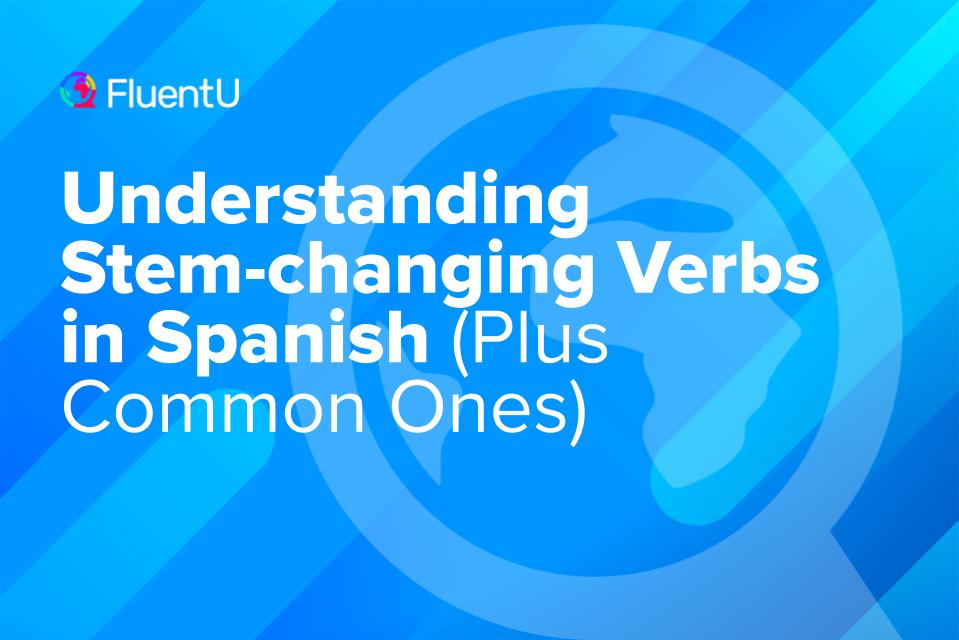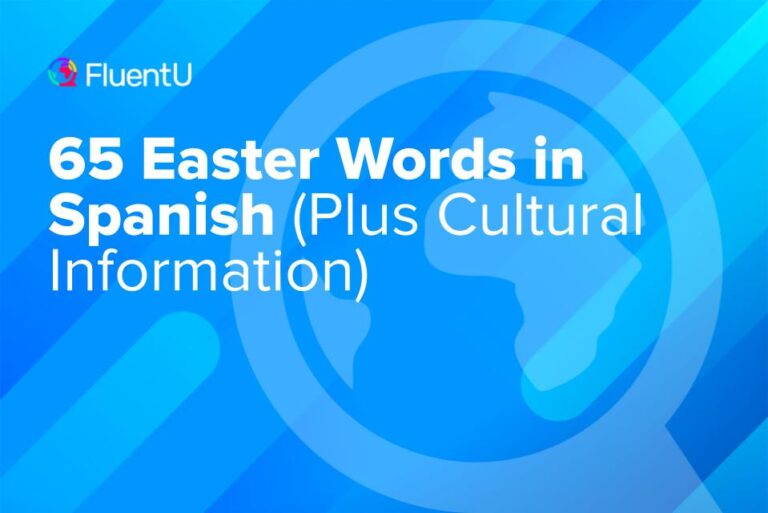Understanding Stem-changing Verbs in Spanish (Plus Common Ones)

Spanish stem-changing verbs don’t follow the normal conjugation rules. Like irregular verbs, you’ll hear them in casual conversations all the time—they seem confusing, but once you know them, they’re easy to use.
After reading this guide, you’ll be able to identify, conjugate and correctly use stem-changing verbs in Spanish.
Download: This blog post is available as a convenient and portable PDF that you can take anywhere. Click here to get a copy. (Download)
What Are Spanish Stem-changing Verbs?
Have you ever wondered why the second-person conjugation for the verb tener (to have) is tú tienes?
Because tener is a stem-changing verb, even though it ends in –er, it doesn’t follow the same rules as normal –er verbs.
Spanish infinitive verbs consist of two parts: a stem and an ending.
For example, the regular verb hablar (to speak) consists of the stem habl- and the ending -ar.
To conjugate hablar in the present tense, you take the stem and add the correct ending (o, a, as, amos, áis, an).
Stem-changing verbs—like tener—don’t follow this pattern. Instead, they have slightly different endings.
There are three basic types of stem-changing verbs:
- e-ie stem-changing verbs (empezar, sentir, querer, etc.)
- e-i stem-changing verbs (decir, repetir, pedir, etc.)
- o-ue stem-changing verbs (poder, volver, dormir, etc.)
How to Conjugate Stem-changing Verbs in Spanish
Stem changes affect verbs in three tenses: the present simple, the past simple and the present continuous.
In the other tenses (such as the imperfect tense and future simple), stem-changing verbs follow the typical conjugation rules.
The Present Simple
In the present simple tense, the stem change applies to all verb forms except for the nosotros and vosotros forms.
For these, you keep the stem the same and treat it like any regular verb.
Let’s look at the e-ie verb empezar (to begin), the e-i verb repetir (to repeat) and the o-ue verb poder (to be able to).
The Past Simple
In the past simple tense, only –ir verbs are stem-changing, and only in the él/ella/usted form and ellos/ellas/ustedes form.
The stem changes are also different from those in the present simple tense.
For e-i stem-changing verbs such as pedir (to ask), change the e to an i (like in the present tense).
For e-ie stem-changing verbs such as sentir (to feel), change the e to an i.
For o-ue stem-changing verbs such as dormir (to sleep), change the o to a u.
The Present Continuous
The present continuous tense comprises two parts: a conjugation of the verb estar (to be) and a gerund. English gerunds are verbs that end in -ing. In Spanish, they end in –ando or –iendo.
Only gerunds for –ir verbs undergo a stem change, and they’re the same as in the past tense.
For e-i stem-changing verbs, change the e to an i.
For e-ie stem-changing verbs, change the e to an i.
For o-ue stem-changing verbs, change the o to a u.
I-E Stem-changing Verbs
Empezar (To begin)
Hoy empiezo mi nuevo trabajo.
(Today I begin my new job.)
Sentirse (To feel)
Se sienten muy felices porque han ganado el partido.
(They feel very happy because they have won the game.)
Querer (To want)
¿Quieres ir al cine?
(Do you want to go to the movies?)
Pensar (To think)
Ella piensa mucho en los demás.
(She thinks a lot about others.)
Preferir (To prefer)
Me gustan las fresas, pero prefiero las manzanas.
(I like strawberries, but I prefer apples.)
Tener (To have)
¿Tienes un bolígrafo?
(Do you have a pen?)
Perder (To lose)
Ella pierde su móvil muy a menudo.
(She loses her phone frequently.)
O-UE Stem-changing Verbs
Poder (To be able to)
Ellos no pueden venir porque tienen que trabajar.
(They can’t come because they have to work.)
Soler (To tend to, to be in the habit of)
Él suele llegar tarde.
(He tends to arrive late.)
Volver (To return)
¿Vuelves a los Estados Unidos después de tu viaje?
(Do you return to the United States after your trip?)
Mover (To move)
Mueve los brazos cuando camina.
(He moves his arms when he walks.)
Dormir (To sleep)
Cada noche duermo 8 horas.
(Every night, I sleep 8 hours.)
Costar (To cost)
La camisa cuesta diez dólares.
(The shirt costs ten dollars.)
E-I Stem-changing Verbs
Pedir (To ask, to request, to order)
Cada vez que voy a ese restaurante, pido la sopa de pollo.
(Every time I go to that restaurant, I order the chicken soup.)
Seguir (To follow, to continue)
Mis gatos siempre me siguen.
(My cats always follow me around.)
Le duele la pierna, pero sigue jugando al fútbol.
(Her leg hurts, but she continues to play football.)
Repetir (To repeat)
La chica repite lo que dice su hermano.
(The girl repeats what her brother says.)
Decir (To say)
Ella dice que a su padre no le gusta la película.
(She says that her father doesn’t like the movie.)
Reír (To laugh)
Él se ríe del chiste.
(He laughs at the joke.)
Sonreír (To smile)
Sonrío cuando te veo.
(I smile when I see you.)
Bonus: U-UE and I-IE Stem-changing Verbs
All Spanish stem-changing verbs fall under one of the previous three categories—except jugar, inquirir and adquirir.
Jugar (to play) is the only u-ue stem-changing verb, and inquirir (to inquire) and adquirir (to acquire) are the only two i-ie verbs.
Jugar (To play)
Inquirir (To inquire)
Adquirir (To acquire)
Once you’ve got the hang of stem-changing verbs in Spanish, your comprehension and ability to express yourself will begin to skyrocket.
Keep practicing and learning more stem-changing verbs by immersing yourself in authentic Spanish content, like the kind you can find on FluentU.
FluentU takes authentic videos—like music videos, movie trailers, news and inspiring talks—and turns them into personalized language learning lessons.
You can try FluentU for free for 2 weeks. Check out the website or download the iOS app or Android app.
P.S. If you decide to sign up now, you can take advantage of our current sale!

With these stem-changing verbs in your arsenal, talking with native speakers, understanding your language partner, watching your favorite telenovelas (soap operas) and singing along to Enrique Iglesias are all about to become much easier.
Download: This blog post is available as a convenient and portable PDF that you can take anywhere. Click here to get a copy. (Download)
And One More Thing…
If you've made it this far that means you probably enjoy learning Spanish with engaging material and will then love FluentU.
Other sites use scripted content. FluentU uses a natural approach that helps you ease into the Spanish language and culture over time. You’ll learn Spanish as it’s actually spoken by real people.
FluentU has a wide variety of videos, as you can see here:

FluentU brings native videos within reach with interactive transcripts. You can tap on any word to look it up instantly. Every definition has examples that have been written to help you understand how the word is used. If you see an interesting word you don’t know, you can add it to a vocab list.

Review a complete interactive transcript under the Dialogue tab, and find words and phrases listed under Vocab.

Learn all the vocabulary in any video with FluentU’s robust learning engine. Swipe left or right to see more examples of the word you’re on.

The best part is that FluentU keeps track of the vocabulary that you’re learning, and gives you extra practice with difficult words. It'll even remind you when it’s time to review what you’ve learned. Every learner has a truly personalized experience, even if they’re learning with the same video.
Start using the FluentU website on your computer or tablet or, better yet, download the FluentU app from the iTunes or Google Play store. Click here to take advantage of our current sale! (Expires at the end of this month.)







